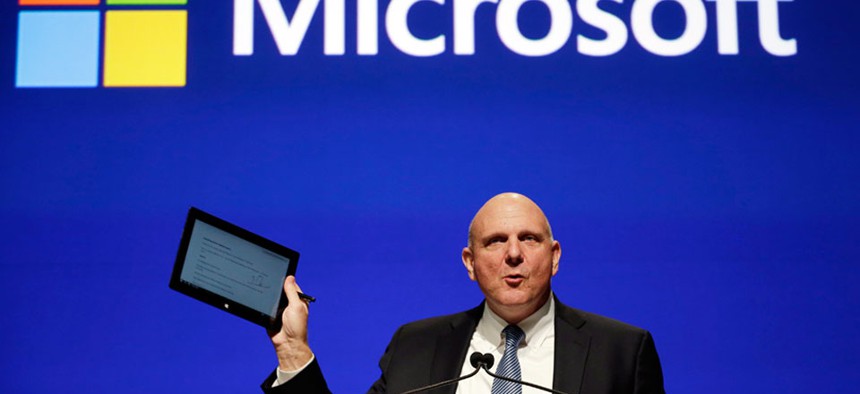Former Microsoft CEO Invests Big In Harvard’s Computer Science Faculty

Former Microsoft CEO Steve Ballmer Elaine Thompson/AP
The field of computer science is undergoing rapid change, Steve Ballmer says.
Steve Ballmer is the former CEO of Microsoft, the owner of the Los Angeles Clippers, and a 1977 Harvard graduate.
The field of computer science — what it is, what it enables, what it takes to do it well — is undergoing rapid change.
Decades of advances in theory and practice have shaped what it now demands of students and scholars, and what it makes possible. When any field undergoes rapid change, what it takes to succeed also changes. New possibilities are created, and new competitors emerge.
Now, the field has turned outward, driving scientific discovery and deepening our knowledge of everything from how the body works to why people form communities to what shapes the global economy. The power of computational thinking has the potential to spark breakthroughs in nearly every sphere of human endeavor.
Few areas of achievement can claim as broad a range of influence as computer science can. But what more can we do to accelerate change? It’s a question I thought a lot about while running Microsoft, and the answer is simple: support the very best talent at a place where talent can be fully realized.
To that end, I am helping support an increase in the size of the computer science faculty at Harvard by 50%. There is, in my mind, no place better positioned to catch the next wave in computer science than greater Boston.
I’ll give you four reasons why:
First, this area has led the scientific revolution in computing. Harvard has been home to major breakthroughs in engineering and applied sciences, from the invention of the first large-scale automatic digital computer to significant advances in cryptography, learning theory, computer graphics and robotics.
During World War II, MIT helped the US Navy design a universal flight simulator that led to the first radar-based air defense system. MIT faculty, including Harvard engineering PhD Leo Beranek, founded Cambridge’s BBN Technologies, which designed and built early Internet infrastructure.
Computer science at Harvard and MIT is thriving today as advances in algorithms, systems and artificial intelligence combine to transform the way in which we live with and interact with computers and information. While Stanford and Carnegie Mellon are serious competitors with strong computer science programs powering important breakthroughs, neither—on their own—match the combined strength of Harvard and MIT.
Second, the next generation of computer science will be outward facing: bringing expertise in harnessing data and computing power not only to statistics, engineering, and applied math, but to biology, chemistry, neuroscience, design, the social sciences and public policy. At Harvard, CS exists as a department without walls, within a school (Engineering and Applied Sciences) known for reaching across disciplines to tackle challenging problems.
MIT and Harvard computer scientists routinely collaborate—edX is one great example—and use each other’s school as a recruiting tool, since students can cross-register for classes at both schools, and it is not unusual for labs to have scientists from both universities. This openness creates an inquisitive and entrepreneurial culture, a tendency to share ideas and collaborate and hustle that is energizing research as well as teaching and learning.
Third, Boston and Cambridge have the unmatched advantage of more top-ranked academic departments than any other metropolitan area in the world.
Where other than Harvard can you find eminent schools of business, law, and medicine and a renowned design school, public policy school and schools of education and public health?
What other region has the Whitehead Institute, the Broad Institute, and the Wyss Institute, all taking the study of biology, medicine and engineering to new heights thanks in large part to what is being enabled by machine learning and big data? Imagine the puzzles we can solve — the questions we can ask — by uniting expertise.
What is intelligence? Which disease patterns can be discerned through new algorithms? How can cities and urban environments become more efficient and more sustainable? It is not an exaggeration to say that in this region, a top-notch collaborator on these and other fundamental questions can be found down the street or even down the hall.
Fourth, Harvard is transforming Allston into a hub of entrepreneurship that will draw on the region’s extraordinary strengths to attract thinkers and doers from around the world.
With a soon-to-be-built signature building for Engineering and Applied Sciences, the University will rethink how spaces are best configured for the education and research of tomorrow, for collaborative research, and for meeting and brainstorming. Kendall Square stands as a testament to what’s possible when land is developed for technology companies — start-ups and giants both — right next to top-notch computer scientists and their collaborators.
Harvard’s dramatically expanded CS faculty will be located just across the street from the existing Innovation Lab and adjacent to a new enterprise zone that will house both start-ups and established businesses. Allston will be the place to be for anyone who wants to watch the ripple of his or her idea spread and gain speed.
Computer science and computational thinking has transformed the world. But too often, ideas generated here have been commercialized on the West Coast.
By hiring the brightest, most creative professors, by educating the world’s best students, and by leveraging the strengths of all of Harvard as well as MIT, this region can catch the next wave and lead the world in shaping the computing of tomorrow.
If successful, Boston will set a standard for the field that will bring the very best of computer science to big problems in every field, and change all of our lives for the better.
NEXT STORY: Lawmakers Hopeful FITARA Finish Line In Sight


